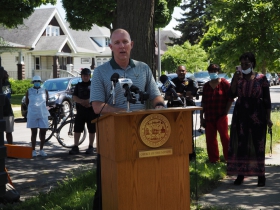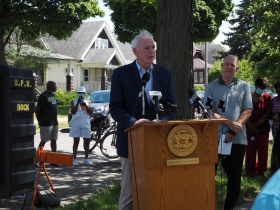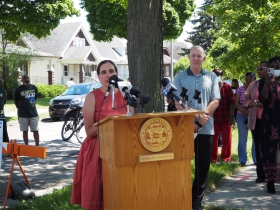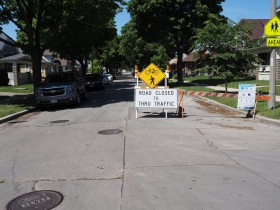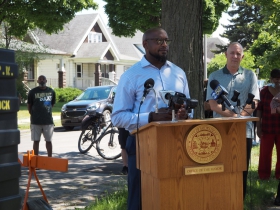Milwaukee’s “Active Streets” Are Back
Program selects streets and parkways to prioritize pedestrian and bicycle traffic.
Milwaukee’s Active Streets program is back for a second year.
Instituted in May 2020 to create additional outdoor recreational space by slowing traffic on city streets amidst the COVID-19 pandemic, the city pivoted to a public-private partnership to operate the program in 2021.
The city places barricades that partially block streets at intersections, discouraging through-traffic while still allowing local access. A survey found that 72% of respondents favored bringing back the program.
“We want to have that small town experience in a city that’s nearly 600,000 people,” said Mayor Tom Barrett.
This year the city released a request for proposals looking for organizations that the city would pay to program and monitor Active Streets sites. Grants worth up to $5,000 will be provided to each group and an additional grant to partner with Artists Working in Education.
Four community groups were selected for 2021, including the Northwest Side Community Development Corporation. Officials gathered Friday at N. 25th St. and W. Hope Ave., just north of W. Capitol Dr., to unveil the NWSCDC’s “active street” on 25th Street.
“These public spaces are for people, not just for cars,” said Department of Public Works transportation planner Kate Riordan.
“None of this could be done without the perseverance of the residents,” said Raymond Monk of the NWSCDC.
Future years could include permanent barriers after a trial of semi-permanent improvements like rubber speed humps and speed tables.
A separate, similarly named program, Active Streets for Business governs the ability of businesses to take over street space for expanded patio seating. Milwaukee County Parks has also partnered in Active Streets, closing off some parkways to vehicle traffic.
Photos
Jeramey Jannene contributed to this report
If you think stories like this are important, become a member of Urban Milwaukee and help support real, independent journalism. Plus you get some cool added benefits.
Political Contributions Tracker
Displaying political contributions between people mentioned in this story. Learn more.
- December 31, 2020 - Tom Barrett received $500 from Jeff Polenske
- December 2, 2018 - Tom Barrett received $400 from Jeff Polenske
- May 25, 2017 - Tom Barrett received $400 from Jeff Polenske
- February 1, 2016 - Tom Barrett received $400 from Jeff Polenske
Transportation
-
Congestion Pricing Cuts Air Pollution in New York City
 Dec 14th, 2025 by Jeff Wood
Dec 14th, 2025 by Jeff Wood
-
FTA Tells Milwaukee to Crack Down on Fare Evasion — Even Where Fares Don’t Exist
 Dec 12th, 2025 by Graham Kilmer
Dec 12th, 2025 by Graham Kilmer
-
Will GOGO’s Bus Service Ever Get Going?
 Dec 9th, 2025 by Jeramey Jannene
Dec 9th, 2025 by Jeramey Jannene



